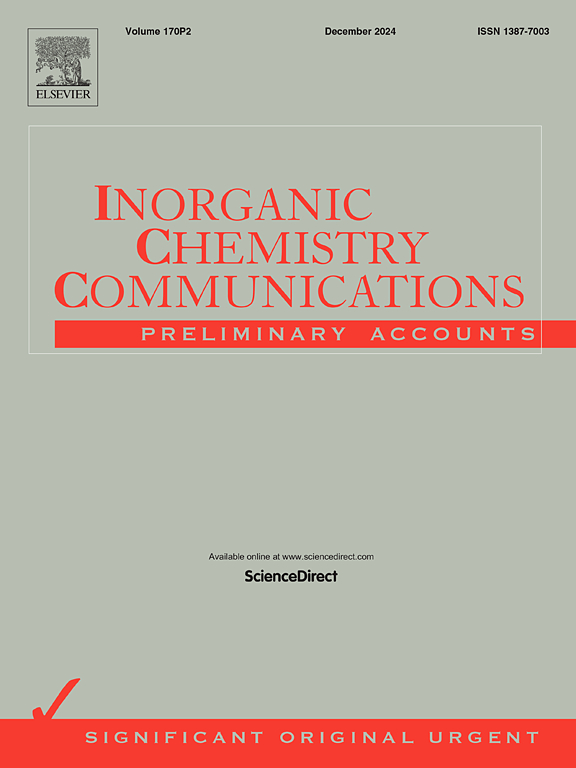Catalytic performance of a copper coordination polymer in the oxidation of styrene: Insights into immobilization and thermal transformation
IF 4.4
3区 化学
Q1 CHEMISTRY, INORGANIC & NUCLEAR
引用次数: 0
Abstract
A metal–organic polymer based on Cu (II) (catalyst 1) was successfully synthesized. The molecular structure of catalyst 1 was analyzed using several methods. Subsequently, catalyst 1 was immobilized onto mesoporous Fe3O4@TiO2 particles, resulting in a new catalyst 2. Heating catalyst 1 to 800 °C led to the formation of CuO particles (catalyst 3). The synthesized catalysts were thoroughly characterized using various analytical techniques, including elemental analysis (CHN), FT-IR spectroscopy, thermal analysis (TGA/DSC), X-ray powder Diffraction (XRD), and Energy-Dispersive X-ray Spectroscopy (EDS). Catalysts 1 to 3 were employed in the oxidation of styrene, utilizing 30 % hydrogen peroxide (H2O2) as the oxidizing agent. The styrene conversion followed the order: 2 > 3 > 1. The catalytic efficiency was influenced by solvent type, temperature, catalyst amount, and oxidant. We optimized these conditions to enhance the performance of the best catalyst. Recyclability test for catalyst 2 showed stability, indicating that 2 remained intact throughout seven successive cycles. The advantageous properties of catalyst 2, including its non-toxic nature, ease of separation, high efficiency, and recyclability, underscore its potential as a promising catalytic material.

铜配位聚合物在苯乙烯氧化中的催化性能:固定化和热转化的见解
成功地合成了一种以Cu (II)为催化剂的金属有机聚合物。采用多种方法对催化剂1的分子结构进行了分析。随后,将催化剂1固定在介孔Fe3O4@TiO2颗粒上,得到新的催化剂2。将催化剂1加热至800°C,形成CuO颗粒(催化剂3)。利用元素分析(CHN)、FT-IR光谱、热分析(TGA/DSC)、x射线粉末衍射(XRD)和能量色散x射线光谱(EDS)等多种分析技术对合成的催化剂进行了全面表征。催化剂1 ~ 3采用30%过氧化氢(H2O2)作为氧化剂氧化苯乙烯。苯乙烯的转化率顺序为:2 >;3比;1. 溶剂类型、温度、催化剂用量和氧化剂对催化效率均有影响。我们对这些条件进行了优化,以提高最佳催化剂的性能。催化剂2的可回收性测试显示稳定性,表明2在连续7次循环中保持完整。催化剂2的优点,包括其无毒、易于分离、高效和可回收性,强调了其作为一种有前途的催化材料的潜力。
本文章由计算机程序翻译,如有差异,请以英文原文为准。
求助全文
约1分钟内获得全文
求助全文
来源期刊

Inorganic Chemistry Communications
化学-无机化学与核化学
CiteScore
5.50
自引率
7.90%
发文量
1013
审稿时长
53 days
期刊介绍:
Launched in January 1998, Inorganic Chemistry Communications is an international journal dedicated to the rapid publication of short communications in the major areas of inorganic, organometallic and supramolecular chemistry. Topics include synthetic and reaction chemistry, kinetics and mechanisms of reactions, bioinorganic chemistry, photochemistry and the use of metal and organometallic compounds in stoichiometric and catalytic synthesis or organic compounds.
 求助内容:
求助内容: 应助结果提醒方式:
应助结果提醒方式:


